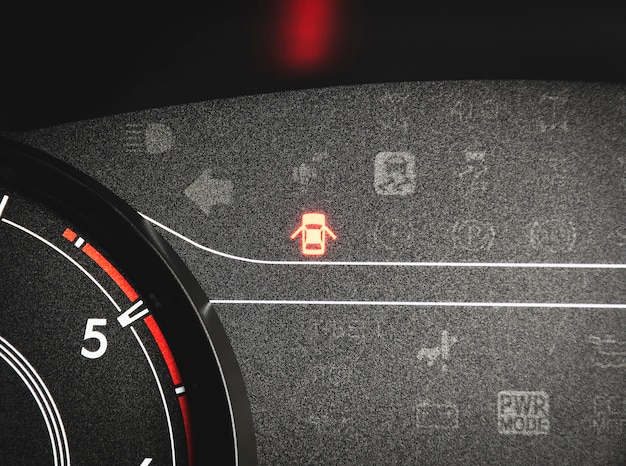2025 Car Buying: How Safety Tech Impacts Your Insurance Costs

The integration of advanced safety technologies in 2025 car models is poised to significantly influence insurance costs, offering potential savings through reduced accident risks while also presenting challenges due to pricier repairs.
Navigating the 2025 car buying landscape involves more than just horsepower and fuel efficiency; the impact of new safety technologies on insurance costs is becoming increasingly crucial. How will these advancements affect your wallet?
Understanding the 2025 Automotive Safety Revolution
The automotive industry is undergoing a rapid transformation, with safety technology at the forefront. Staying ahead of the curve requires understanding the nuances of these advancements and their potential financial impact.
Advanced Driver-Assistance Systems (ADAS)
ADAS includes features like automatic emergency braking, lane departure warning, and adaptive cruise control. These systems are designed to mitigate accidents and enhance driver awareness.
The Role of Sensors and Cameras
Modern vehicles are equipped with a network of sensors and cameras that provide a 360-degree view of the surroundings. This data is used to power ADAS and other safety features.
- Reduced Accident Rates: ADAS can significantly decrease the likelihood of collisions.
- Enhanced Road Awareness: Sensors and cameras provide comprehensive environmental data.
- Improved Driver Response Times: Automated systems can react faster than human drivers in critical situations.

The evolution of automotive safety is closely tied to technological advancements that aim to make driving safer and more predictable. As these technologies become more sophisticated, their effect on insurance rates becomes a central factor for consumers making purchasing decisions.
The Direct Impact of Safety Tech on Insurance Premiums
While the integration of advanced safety technologies may lead to higher initial costs for vehicles, the potential long-term savings through reduced insurance premiums can be substantial.
Potential Discounts for Equipped Vehicles
Many insurance companies offer discounts to drivers who own vehicles equipped with ADAS and other safety features. These discounts reflect the decreased risk of accidents.
Factors Affecting Discount Amounts
The specific safety features a vehicle has, the driver’s history, and the insurance provider’s policies all play a role in determining the discount amount.
- Type of Safety Features: More comprehensive systems often result in larger discounts.
- Driving Record: A clean driving record can amplify the benefits of safety tech.
- Insurance Company Policies: Different providers have varying approaches to safety-related discounts.
The allure of lower insurance premiums can serve as a powerful incentive for consumers to prioritize safety technologies when buying a car. By making a well-informed decision, buyers can not only ensure safer driving but also reduce long-term costs associated with vehicle ownership.
Potential Drawbacks: Repair Costs and Technological Vulnerabilities
Despite the benefits, there are potential drawbacks to consider. The advanced technology in modern vehicles can lead to higher repair costs, and there’s also the risk of technological vulnerabilities.
Increased Repair Expenses for Advanced Systems
Sensors, cameras, and other components are often expensive to repair or replace. Even minor accidents can result in significant repair bills.
Cybersecurity Risks and Vehicle Hacking
Connected vehicles are vulnerable to hacking, which can compromise safety systems and lead to accidents or theft.
The advantages of ADAS are clear, but it’s crucial to be aware of the possible drawbacks, especially as these systems become more deeply ingrained in automobiles. As technology advances, manufacturers and consumers alike must focus on developing safer, more user-friendly, and secure systems.

How Insurance Companies Assess Safety Technology
Insurance companies are constantly refining their methods for assessing the impact of safety technology. This assessment involves analyzing data and adjusting policies to reflect the changing risk landscape.
Data Collection and Analysis
Insurers collect data on accident rates, repair costs, and other factors to determine the effectiveness of different safety features.
Adjusting Policies Based on Real-World Data
As more data becomes available, insurance companies adjust their policies to more accurately reflect the real-world impact of safety technology.
- Analyzing Accident Rates: Insurers track how often vehicles with ADAS are involved in accidents.
- Evaluating Repair Costs: The cost of repairing advanced systems is a key consideration.
- Predictive Modeling: Insurers use data to predict future risks and adjust premiums accordingly.
The assessment of safety technology by insurance companies directly shapes their pricing strategies and policy designs, thus impacting the end costs for the consumer. This continuous evaluation promotes ongoing safety enhancements in vehicle design and encourages drivers to adopt these potentially life-saving technologies.
Future Trends in Automotive Safety and Insurance
Looking ahead, several trends are poised to shape the future of automotive safety and insurance. These trends include increased automation, enhanced connectivity, and new insurance models.
The Rise of Autonomous Vehicles
Self-driving cars have the potential to revolutionize transportation, but they also raise complex insurance questions. The transition to fully autonomous vehicles will require significant adjustments to existing insurance frameworks.
Telematics and Usage-Based Insurance
Telematics systems can track driving behavior and provide personalized insurance rates. Usage-based insurance models are becoming increasingly popular.
The future of automotive safety and insurance involves not only technological progress but also the growth of data-driven risk management and customized insurance products, leading to a more dynamic and user-centric approach to vehicle insurance.
Making Informed Car Buying Decisions in 2025
To make informed car buying decisions in 2025, it’s essential to consider both the upfront costs of safety technology and the potential long-term savings on insurance. Weighing these factors can help you find the best value.
Researching Safety Features and Insurance Discounts
Take the time to research the safety features available on different models and compare insurance discounts. This research can help you make an informed decision.
Consulting with Insurance Providers
Talk to your insurance provider about potential discounts and how specific safety features may affect your premiums. Understanding these aspects can help you plan financially and make better value assessments for your purchase.
- Comparing Vehicle Safety Ratings: Look at ratings from organizations like IIHS and NHTSA.
- Checking Insurance Company Policies: Understand how different companies view safety technology.
- Considering Long-Term Costs: Factor in potential insurance savings over the life of the vehicle.
In summary, making smart car-buying decisions in 2025 means considering the complex interaction between technology, safety, and insurance expenses. Balancing the allure of modern innovations with practical savings and safety implications is key to getting the most value for your money.
| Key Point | Brief Description |
|---|---|
| 🛡️ ADAS Impact | Advanced Driver-Assistance Systems can lower accident risks. |
| 💰 Insurance Discounts | Vehicles with safety tech may qualify for insurance reductions. |
| 🛠️ Repair Costs | Advanced systems can lead to higher repair expenses. |
| 🔒 Cybersecurity Risks | Connected vehicles face potential hacking vulnerabilities. |
Frequently Asked Questions
▼
Advanced safety features can lower insurance rates by reducing the risk of accidents and injuries. Insurers often provide discounts for vehicles equipped with these technologies due to their proven safety benefits.
▼
Technologies like automatic emergency braking, lane departure warning, adaptive cruise control, and blind-spot monitoring often qualify for discounts. The availability and amount of the discount can vary by insurer.
▼
Yes, one potential drawback is the increased cost of repairs. Advanced sensors and systems can be expensive to fix or replace after an accident, potentially offsetting some of the savings from lower premiums.
▼
Autonomous vehicles have the potential to lower insurance costs in the long term by reducing accidents. However, the transition period may involve complex insurance models and coverage considerations as technology evolves.
▼
Contact your insurance provider and inquire about specific discounts for safety features. You can also consult your vehicle’s manual and safety ratings from organizations like IIHS and NHTSA to identify applicable technologies.
Conclusion
As the automotive industry evolves, the integration of new safety technologies is significantly impacting insurance costs for 2025 car buying. While these advancements promise potential savings through reduced accident risks, it’s crucial to weigh repair costs and technological vulnerabilities to make informed decisions. By staying informed and consulting with insurance providers, consumers can navigate the changing landscape and find the best value for their vehicle purchases.





